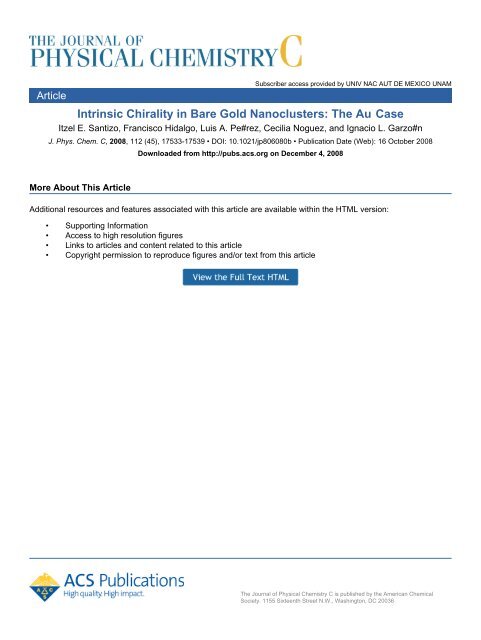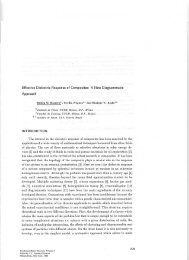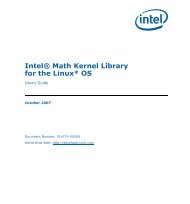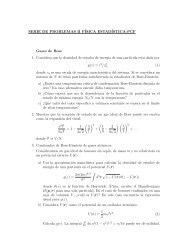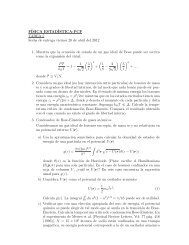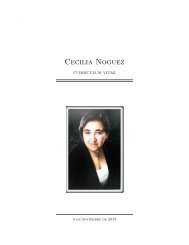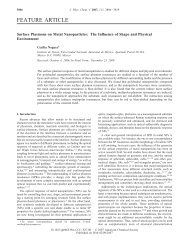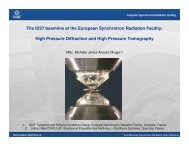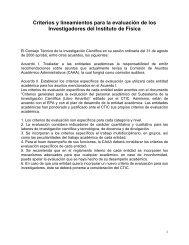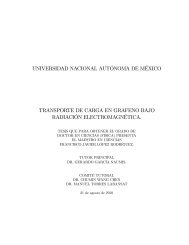Intrinsic Chirality in Bare Gold Nanoclusters: The Au34# Case - UNAM
Intrinsic Chirality in Bare Gold Nanoclusters: The Au34# Case - UNAM
Intrinsic Chirality in Bare Gold Nanoclusters: The Au34# Case - UNAM
You also want an ePaper? Increase the reach of your titles
YUMPU automatically turns print PDFs into web optimized ePapers that Google loves.
Article<br />
Subscriber access provided by UNIV NAC AUT DE MEXICO <strong>UNAM</strong><br />
34#<br />
<strong>Intr<strong>in</strong>sic</strong> <strong>Chirality</strong> <strong>in</strong> <strong>Bare</strong> <strong>Gold</strong> <strong>Nanoclusters</strong>: <strong>The</strong> Au<br />
<strong>Case</strong><br />
Itzel E. Santizo, Francisco Hidalgo, Luis A. Pe#rez, Cecilia Noguez, and Ignacio L. Garzo#n<br />
J. Phys. Chem. C, 2008, 112 (45), 17533-17539 • DOI: 10.1021/jp806080b • Publication Date (Web): 16 October 2008<br />
Downloaded from http://pubs.acs.org on December 4, 2008<br />
More About This Article<br />
Additional resources and features associated with this article are available with<strong>in</strong> the HTML version:<br />
• Support<strong>in</strong>g Information<br />
• Access to high resolution figures<br />
• L<strong>in</strong>ks to articles and content related to this article<br />
• Copyright permission to reproduce figures and/or text from this article<br />
<strong>The</strong> Journal of Physical Chemistry C is published by the American Chemical<br />
Society. 1155 Sixteenth Street N.W., Wash<strong>in</strong>gton, DC 20036
J. Phys. Chem. C 2008, 112, 17533–17539 17533<br />
<strong>Intr<strong>in</strong>sic</strong> <strong>Chirality</strong> <strong>in</strong> <strong>Bare</strong> <strong>Gold</strong> <strong>Nanoclusters</strong>: <strong>The</strong> Au 34 - <strong>Case</strong><br />
Itzel E. Santizo, Francisco Hidalgo, Luis A. Pérez, Cecilia Noguez, and Ignacio L. Garzón*<br />
Instituto de Física, UniVersidad Nacional Autónoma de México, Apartado Postal 20-364,<br />
01000 México D. F., México<br />
ReceiVed: July 9, 2008; ReVised Manuscript ReceiVed: August 10, 2008<br />
In this work, we provide theoretical evidence on the existence of energetically stable chiral structures for<br />
bare gold clusters. Density functional theory calculations with<strong>in</strong> the generalized-gradient approximation were<br />
performed to systematically study structural, vibrational, electronic, and optical properties of the lowestly<strong>in</strong>g<br />
isomers of the Au 34Z ,(Z )+1, 0, -1), clusters. Our results show that for the neutral and charged<br />
clusters, the lowest-energy isomer has a C 1 (chiral) structure. In addition, a C 3 (chiral) isomer was found<br />
nearly degenerate <strong>in</strong> energy with the C 1 isomer. <strong>The</strong>se results are <strong>in</strong> agreement with previous theoreticalexperimental<br />
studies done for the Au 34- cluster; however, because our calculated molecular scatter<strong>in</strong>g functions<br />
for the C 1 and C 3 isomers of this cluster are almost <strong>in</strong>dist<strong>in</strong>guishable, it is concluded that the actual resolution<br />
<strong>in</strong> trapped ion electron diffraction experiments is not enough to discrim<strong>in</strong>ate between them. On the other<br />
hand, the electronic density of states of the C 1 isomer shows better overall agreement with the measured<br />
photoelectron spectrum of the Au 34- cluster than that one correspond<strong>in</strong>g to the C 3 isomer. <strong>The</strong> electronic<br />
density of states of these isomers also shows different features <strong>in</strong> the energy region of the HOMO-LUMO<br />
gap, which would generate dist<strong>in</strong>ct behavior <strong>in</strong> their optical properties. In fact, the calculated absorption and<br />
circular dichroism spectra of the two chiral isomers show clear differences <strong>in</strong> their l<strong>in</strong>e shape. Another important<br />
property that dist<strong>in</strong>guishes the C 1 and C 3 isomers is the different spatial distribution of the atomic coord<strong>in</strong>ation<br />
on the cluster surface. Our results confirm that the potential energy surface of bare gold clusters could have<br />
lowest-ly<strong>in</strong>g energy m<strong>in</strong>ima correspond<strong>in</strong>g to <strong>in</strong>tr<strong>in</strong>sically chiral structures.<br />
Introduction<br />
<strong>The</strong> theoretical and experimental study of energetically stable<br />
structures of gold clusters is an important and very active field<br />
of research. 1 By comb<strong>in</strong><strong>in</strong>g techniques like cluster ion mobility<br />
(CIM), 2 photoelectron spectroscopy (PES), 3,4 and trapped ion<br />
electron diffraction (TIED), 5 with density functional theory<br />
(DFT) calculations, <strong>in</strong>terest<strong>in</strong>g trends on the structural motifs<br />
of the lowest-energy isomers of gold clusters have been reported.<br />
For example, for anionic Au n- clusters with n < 13, 2D<br />
structures were proposed, 3,5 whereas for n ) 16-18 empty cagelike<br />
structures 6 have been detected. A perfect tetrahedron for<br />
the Au 20- cluster, 7 and tetrahedral-based structures 5,8,9 for n )<br />
21-23 have also been reported. For Au 24- , a hollow tubular<br />
structure was proposed, 5,8,9 but, <strong>in</strong>terest<strong>in</strong>gly, only up to n )<br />
25 a core-shell structure with a s<strong>in</strong>gle core atom was obta<strong>in</strong>ed. 9<br />
Another <strong>in</strong>terest<strong>in</strong>g case is the Au 32 neutral cluster with an<br />
I h cage-like structure that was theoretically predicted as the<br />
lowest-energy isomer; 10,11 however, PES measurements on the<br />
Au 32- cluster, taken at room temperature, <strong>in</strong>dicated that a lowsymmetry<br />
compact C 1 isomer fits best the experimental data. 12<br />
A recent theoretical study 13 showed that, although the lowestenergy<br />
structure of the Au 32 neutral cluster <strong>in</strong>deed corresponds<br />
to the I h cage-like structure, the energetic order<strong>in</strong>g of the lowestly<strong>in</strong>g<br />
isomers change for the anionic Au 32- cluster. In that<br />
study, 13 a systematic search of the lowest-energy m<strong>in</strong>ima was<br />
performed comb<strong>in</strong><strong>in</strong>g a global optimization technique (genetic<br />
algorithms) and a many-body Gupta potential with a further<br />
local m<strong>in</strong>imization, us<strong>in</strong>g DFT calculations with<strong>in</strong> the generalized-gradient<br />
approximation (GGA). <strong>The</strong> results obta<strong>in</strong>ed<br />
* To whom correspondence should be addressed. E-mail: garzon@<br />
fisica.unam.mx. Phone: +52-55-56225147. Fax: +52-55-561651535.<br />
showed that the lowest-energy isomer of the Au 32- cluster<br />
corresponds to a low-symmetry C 1 compact structure, <strong>in</strong>dicat<strong>in</strong>g<br />
that a s<strong>in</strong>gle additional charge is enough to modify the energetic<br />
order<strong>in</strong>g of the neutral cluster isomers. 13 This study also predicts<br />
that low-symmetry disordered structures, for both the Au 32- and<br />
the Au 32+ clusters, should be detected not only at room<br />
temperature as was experimentally verified for the Au 32- case 12<br />
but also at much lower temperatures. 13<br />
<strong>The</strong> search for the most stable structure of the large-band<br />
gap (0.94-0.96 eV) Au - 34 cluster has also received special<br />
attention recently. 14,15 In a theoretical-experimental study,<br />
comb<strong>in</strong><strong>in</strong>g PES, TIED, and time-dependent DFT calculations,<br />
it was suggested that an isomer with C 3 (chiral) po<strong>in</strong>t symmetry<br />
is the most abundant <strong>in</strong> the <strong>in</strong>vestigated ensemble of sizeselected<br />
clusters. 14 In other work, the structural and electronic<br />
properties of the Au 34- cluster were also <strong>in</strong>vestigated us<strong>in</strong>g<br />
accurate theoretical calculations and PES. 15 In contrast with the<br />
former study, 14 <strong>in</strong> the latter one, it was concluded that a<br />
disordered-fluxional isomer with C 1 po<strong>in</strong>t symmetry is the most<br />
likely candidate responsible of the PES data. 15 In both studies, 14,15<br />
it was also found that there are other lowest-ly<strong>in</strong>g isomers very<br />
close <strong>in</strong> energy with respect to either the C 3 or the C 1 isomers,<br />
but after a data analysis it was concluded that they only provide<br />
m<strong>in</strong>or contributions to the TIED 14 and PES 14,15 spectra. <strong>The</strong><br />
lack of agreement <strong>in</strong> the structure determ<strong>in</strong>ation of the isomers<br />
of the Au - 34 cluster that makes the major contribution to the<br />
TIED 14 and PES 14,15 data is surpris<strong>in</strong>g s<strong>in</strong>ce both studies used<br />
state of the art experimental techniques <strong>in</strong> conjunction with<br />
accurate quantum mechanical calculations. On the other hand,<br />
although the C 3 and C 1 isomers belong to different rotational<br />
symmetry groups, and therefore they are structurally different,<br />
10.1021/jp806080b CCC: $40.75 © 2008 American Chemical Society<br />
Published on Web 10/16/2008
17534 J. Phys. Chem. C, Vol. 112, No. 45, 2008 Santizo et al.<br />
it is appeal<strong>in</strong>g that both isomers, by def<strong>in</strong>ition, 16 correspond to<br />
metallic chiral nanostructures.<br />
<strong>Chirality</strong> <strong>in</strong> bare and thiolate-passivated gold clusters had been<br />
studied before 17-19 to provide theoretical <strong>in</strong>sights <strong>in</strong>to the<br />
physicochemical orig<strong>in</strong> of the giant optical activity measured<br />
on glutathione-passivated gold clusters 20 and on other related<br />
systems. 21 <strong>The</strong> study of the enantiospecific adsorption of a chiral<br />
am<strong>in</strong>o acid on a chiral Au 55 cluster 22 has also shown the<br />
relevance and possible applications of chiral gold clusters. It<br />
is, therefore, encourag<strong>in</strong>g the existence of experimental evidence<br />
of chiral structures for the bare Au - 34 cluster, with either C 3 or<br />
C 1 rotational symmetry group.<br />
In this work, we provide additional theoretical evidence on<br />
the existence of energetically stable (lowest-ly<strong>in</strong>g local m<strong>in</strong>ima<br />
of the potential energy surface) chiral structures for the Au Z 34 ,<br />
(Z ) +1, 0, -1), clusters, by study<strong>in</strong>g their structural,<br />
vibrational, electronic, and optical properties, us<strong>in</strong>g DFT-GGA<br />
calculations. This study is useful by itself and also because, as<br />
mentioned above, there is not yet agreement <strong>in</strong> the structure<br />
determ<strong>in</strong>ation of the Au - 34 cluster after comb<strong>in</strong><strong>in</strong>g TIED, PES,<br />
and theoretical calculations. 14,15 Our results show that for the<br />
neutral and charged clusters, the lowest-energy isomer is a<br />
disordered C 1 (chiral) structure. This C 1 isomer corresponds to<br />
the structure first reported <strong>in</strong> ref 15, which is the ma<strong>in</strong><br />
contributor to the measured PES spectra of the Au - 34 cluster.<br />
For the Au - 34 cluster, we also obta<strong>in</strong>ed that the C 3 isomer, first<br />
reported <strong>in</strong> ref 14, is nearly degenerate <strong>in</strong> energy with the C 1<br />
isomer (our calculated total energy difference is: 0.031 eV).<br />
Because the theoretical calculated molecular scatter<strong>in</strong>g functions<br />
of the two chiral structures are very similar, we conclude that<br />
the present resolution of the TIED technique is not enough to<br />
clearly discrim<strong>in</strong>ate between the C 1 and C 3 isomers of the Au<br />
- 34<br />
cluster. On the other hand, the calculated electronic density of<br />
states (DOS) of the C 1 isomer is <strong>in</strong> better agreement with the<br />
measured photoelectron spectrum than that one correspond<strong>in</strong>g<br />
to the C 3 structure. <strong>The</strong> DOS of both chiral isomers show major<br />
differences, particularly <strong>in</strong> the HOMO-LUMO energy gap<br />
region, which will affect differently the optical behavior of them.<br />
To confirm this hypothesis, we have calculated the absorption<br />
and circular dichroism (CD) spectra of the C 1 and C 3 isomers.<br />
Our results confirm that these isomers are <strong>in</strong>tr<strong>in</strong>sically chiral<br />
because the calculated CD spectra of both isomers are different<br />
from zero, but their l<strong>in</strong>e shape is not the same, imply<strong>in</strong>g that<br />
they respond differently to the <strong>in</strong>teraction with circularly<br />
polarized light. Our results also show that another important<br />
property that dist<strong>in</strong>guishes the C 1 and C 3 isomers is the different<br />
atomic coord<strong>in</strong>ation on the cluster surface, which may produce<br />
dist<strong>in</strong>ct enantiospecific patterns when they <strong>in</strong>teract with chiral<br />
molecules. 22 Overall, our present calculations confirm the<br />
existence of <strong>in</strong>tr<strong>in</strong>sic chiral Au - 34 cluster isomers correspond<strong>in</strong>g<br />
to lowest-ly<strong>in</strong>g m<strong>in</strong>ima of its potential energy surface.<br />
Computational Methods<br />
<strong>The</strong> structural optimization of the gold clusters presented<br />
here<strong>in</strong> was performed follow<strong>in</strong>g a procedure similar to that<br />
reported <strong>in</strong> previous publications by our group. 13,17,18,22-25 At<br />
the last stage of the calculations, the cluster structures were<br />
optimized by unconstra<strong>in</strong>ed relaxations us<strong>in</strong>g the forces calculated<br />
from DFT. <strong>The</strong> DFT-GGA calculations were performed<br />
with the SIESTA code 26 us<strong>in</strong>g scalar relativistic norm-conserv<strong>in</strong>g<br />
pseudopotentials, 27 a double-ζ basis set, 13,22,25 and the Perdew-<br />
Burke-Ernzerhof (PBE) parametrization. 28 For the cluster<br />
structure optimization, a force tolerance of 0.01 eV/Å was used;<br />
whereas for the vibrational frequencies calculation this value<br />
was decreased to 0.001 eV/Å. This methodology has been used<br />
before to study the trends <strong>in</strong> the structure and bond<strong>in</strong>g of noble<br />
metal clusters. 13,25,29 In particular, the energetic, structural, and<br />
electronic properties of neutral and charged Au n ,(n ) 2-13)<br />
clusters, as well as the relative stability of the Au 20 and Au 32<br />
clusters were studied us<strong>in</strong>g the same level of approximation as<br />
mentioned above, 13,25,29 obta<strong>in</strong><strong>in</strong>g good agreement with other<br />
theoretical studies and with experimental data, when they were<br />
available. For example, the DFT-GGA-PBE methodology we<br />
utilized <strong>in</strong> the present calculations had been used before to<br />
<strong>in</strong>vestigate the most stable configuration of the neutral Au 8<br />
cluster. 25,29 <strong>The</strong> results obta<strong>in</strong>ed <strong>in</strong>dicate that the capped square<br />
planar structure is the most-stable one, 25,29 <strong>in</strong> agreement with<br />
the high-level correlation wave function data recently reported<br />
by Olson and Gordon. 30 Although we consider that the conclusions<br />
obta<strong>in</strong>ed <strong>in</strong> the above-mentioned studies on smaller noble<br />
metal clusters 13,25,29 justify the use of the same methodology<br />
for the <strong>in</strong>vestigation of structural properties of neutral and<br />
charged Au 34 clusters, it is important to mention that questions<br />
related to the use of other exchange-correlation functionals, sp<strong>in</strong>polarization<br />
calculations, and effects due a larger basis set or<br />
sp<strong>in</strong>-orbit coupl<strong>in</strong>g have not been considered <strong>in</strong> the present<br />
work. Instead, a systematic search for the most stable configurations<br />
of neutral and charged Au 34 clusters was attempted by<br />
perform<strong>in</strong>g local structural relaxations us<strong>in</strong>g DFT-GGA-PBE<br />
forces on the cluster geometries obta<strong>in</strong>ed from a global<br />
optimization procedure, comb<strong>in</strong><strong>in</strong>g genetic algorithms and a<br />
semiempirical many-body potential. 13,17,18,22-24<br />
<strong>The</strong> chiroptical properties of the C 1 and C 3 isomers of the<br />
Au - 34 cluster were theoretically studied by calculat<strong>in</strong>g their CD<br />
and optical absorption spectra. In particular, the electronic CD<br />
spectrum was evaluated from the Rosenfeld equation 31 for the<br />
rotationalstrength:G Rβ (ω))-2/pIm∑ n+0 ω〈ψ 0 |µ R |ψ n 〉〈ψ n |m β |ψ 0 〉/<br />
ω 2 n0 -ω 2 , where Im denotes the imag<strong>in</strong>ary part of the scalar<br />
product of the matrix elements µ 0n R and m n0 β of the respective<br />
Cartesian components of the electric and magnetic dipole<br />
moments that correspond to a transition from the ground state<br />
ψ 0 to the excited state ψ n , and ω is the frequency of the <strong>in</strong>cident<br />
radiation field, which is circularly polarized. <strong>The</strong> trace of G is<br />
proportional to the CD signal, which is given by the difference<br />
of the molar ext<strong>in</strong>ction (∆ɛ) between left- and right-circularly<br />
polarized light. 31 Here, we consider electronic transitions over<br />
all occupied and unoccupied states, generated by the extendedfunction<br />
basis set that assures convergence of the chiroptical<br />
effects. Dur<strong>in</strong>g the past few years, considerable progress has<br />
been made to perform direct calculations of optical rotatory<br />
strengths based on the evaluation of matrix elements of both<br />
electric and magnetic transition moments us<strong>in</strong>g advanced<br />
quantum descriptions of the molecular excited states like timedependent<br />
DFT (TDDFT). 32 Nevertheless, this methodology<br />
suffers the lack of precision by problems with the basis set<br />
completeness and with the treatment of dynamic electron<br />
correlation, 33 and on the other hand, is still unpractical to study<br />
the chiroptical properties of gold clusters with the size of <strong>in</strong>terest<br />
<strong>in</strong> this work, due the huge computational effort <strong>in</strong>volved. In<br />
this work, we follow an alternative approach <strong>in</strong>corporat<strong>in</strong>g the<br />
appropriate quantum mechanical expressions, based on timedependent<br />
perturbation theory, to calculate the CD and optical<br />
absorption spectra with<strong>in</strong> the framework of the SIESTA program.<br />
34 With<strong>in</strong> this approach the matrix elements of the electric<br />
and magnetic dipole transition moments were calculated us<strong>in</strong>g<br />
as f<strong>in</strong>al states, the unoccupied molecular orbitals generated by<br />
the partially occupied 6s and polarization 6p orbitals form<strong>in</strong>g<br />
the basis set. 35 This methodology has been tested for several
<strong>Intr<strong>in</strong>sic</strong> <strong>Chirality</strong> <strong>in</strong> <strong>Bare</strong> <strong>Gold</strong> <strong>Nanoclusters</strong> J. Phys. Chem. C, Vol. 112, No. 45, 2008 17535<br />
Figure 2. Calculated molecular scatter<strong>in</strong>g function for the C 1 (blue),<br />
C 3 (black), and C 3v (red) isomers of the Au 34- cluster.<br />
Figure 1. Optimized geometries for the Au 34- clusters obta<strong>in</strong>ed at<br />
the DFT-GGA-PBE level of theory.<br />
TABLE 1: Table 1<br />
isomer Au 34<br />
-<br />
HCM isomer Au 34 isomer Au 34<br />
+<br />
1 0.000 0.115 1 0.000 1 0.000<br />
2 0.031 0.121 4 0.134 2 0.170<br />
3 0.080 0.004 5 0.161 3 0.184<br />
4 0.099 0.007 3 0.181 4 0.187<br />
5 0.144 0.102 2 0.182 6 0.280<br />
6 0.152 0.006 6 0.222 7 0.415<br />
7 0.355 0.089 8 0.600 5 0.469<br />
8 0.491 0.018 7 0.607 8 0.494<br />
9 0.638 0.006 9 0.801 9 0.538<br />
carbon nanotubes 34 and chiral molecules and fullerenes 35 like<br />
C 76 and C 84 , obta<strong>in</strong><strong>in</strong>g good agreement with previous TDDFT<br />
calculations and experimental results. 34,35<br />
Results and Discussion<br />
<strong>The</strong> structural optimization of the Au Z 34 (Z )-1, 0, 1)<br />
clusters, us<strong>in</strong>g the DFT-GGA methodology described above,<br />
allows us to obta<strong>in</strong> the isomers with the lowest total energy,<br />
which would correspond to the most stable cluster structures.<br />
<strong>The</strong> n<strong>in</strong>e isomers with the lowest energy we obta<strong>in</strong>ed for the<br />
Au - 34 cluster are displayed <strong>in</strong> Figure 1, 36 whereas the correspond<strong>in</strong>g<br />
relative total energies are presented <strong>in</strong> Table 1. <strong>The</strong><br />
lowest energy isomer we found for the Au - 34 cluster is that<br />
one with C 1 (chiral) po<strong>in</strong>t symmetry. This structure was first<br />
obta<strong>in</strong>ed by Gu et al., 15 us<strong>in</strong>g a bas<strong>in</strong>-hopp<strong>in</strong>g global optimization<br />
technique comb<strong>in</strong>ed with the DFT-GGA method. An<br />
<strong>in</strong>terest<strong>in</strong>g result from the present study is that the same C 1<br />
isomer is also the most stable configuration for the neutral Au 34<br />
and cationic Au + 34 clusters. This is <strong>in</strong> contrast with the trend<br />
we obta<strong>in</strong>ed <strong>in</strong> the study of the structural properties of the Au Z 32 ,<br />
(Z )-1, 0, 1), clusters, where the most stable isomer for the<br />
neutral Au 32 cluster is the I h cagelike isomer, whereas for the<br />
anionic and cationic Au 32 clusters, a C 1 structure is the most<br />
stable one. 13 Table 1 also shows the relative total energies of<br />
the neutral Au 34 and cationic Au + 34 cluster isomers tak<strong>in</strong>g as<br />
reference, like <strong>in</strong> the case of the anionic case, the total energy<br />
of the correspond<strong>in</strong>g most stable C 1 isomer.<br />
For the anionic Au - 34 cluster, an isomer with C 3 (chiral) po<strong>in</strong>t<br />
symmetry, isomer 2, was found nearly degenerate <strong>in</strong> energy<br />
(∆E ) 0.031 eV) with the C 1 isomer. Isomer 2 is also the second<br />
one <strong>in</strong> the energy order<strong>in</strong>g for the cationic Au + 32 cluster, but<br />
the difference <strong>in</strong> energy with the C 1 isomer is higher (∆E )<br />
0.170 eV); whereas for the neutral case, it is the fifth isomer,<br />
0.181 eV higher <strong>in</strong> energy. <strong>The</strong> C 3 isomer was first reported <strong>in</strong><br />
ref 14 as the most stable isomer for the Au - 34 cluster after a<br />
limited structural optimization us<strong>in</strong>g DFT; whereas <strong>in</strong> ref 15 it<br />
was found as the third isomer <strong>in</strong> the energy order<strong>in</strong>g.<br />
<strong>The</strong> relative total energies shown <strong>in</strong> Table 1 <strong>in</strong>dicate that the<br />
energy order<strong>in</strong>g of the n<strong>in</strong>e lowest-ly<strong>in</strong>g isomers is the same<br />
for the anionic and cationic 34 atom gold clusters, but <strong>in</strong> the<br />
case of the neutral cluster, these isomers are distributed <strong>in</strong> a<br />
different way. This result, also found <strong>in</strong> the structural optimization<br />
of the Au Z 32 ,(Z )-1, 0, 1), clusters, 13 confirms the trend<br />
that the addition or subtraction of a s<strong>in</strong>gle charge on a neutral<br />
gold cluster with as many as 34 atoms could be enough to<br />
modify the energy order<strong>in</strong>g of their isomers.<br />
<strong>The</strong> geometries of isomers 3-9 of the Au - 34 clusters displayed<br />
<strong>in</strong> Figure 1 correspond to low-symmetry and chiral structures.<br />
Isomers 3, 4, 6, and 9 only have a s<strong>in</strong>gle plane of symmetry (C s<br />
po<strong>in</strong>t symmetry) and isomers 5, 7, and 8 have no symmetry at all<br />
(C 1 po<strong>in</strong>t symmetry). <strong>The</strong> four isomers with C s po<strong>in</strong>t symmetry<br />
are achiral whereas the rema<strong>in</strong><strong>in</strong>g 3 isomers with C 1 po<strong>in</strong>t<br />
symmetry are chiral. One way to quantify, from a geometrical po<strong>in</strong>t<br />
of view, the <strong>in</strong>dex of chirality of these isomers is through the<br />
Hausdorff chirality measure (HCM), which was <strong>in</strong>troduced <strong>in</strong> refs<br />
17-19. <strong>The</strong> calculated HCM values for the 9 isomers of the Au<br />
- 34<br />
cluster are displayed <strong>in</strong> Table 1. As expected, the HCM values for<br />
the four achiral isomers are almost equal to zero, whereas the C 3<br />
isomer has the largest <strong>in</strong>dex of chirality. <strong>The</strong> energetic predom<strong>in</strong>ance<br />
of chiral and low-symmetry structures for the lowest-ly<strong>in</strong>g<br />
isomers of gold clusters around the present size is another emerg<strong>in</strong>g<br />
trend that from this and other related calculations can now be firmly<br />
established.<br />
<strong>The</strong> results discussed above on the energetic order<strong>in</strong>g of the<br />
most stable isomers of the Au - 34 cluster are <strong>in</strong> good agreement<br />
with those obta<strong>in</strong>ed by Gu et al. 15 In particular, we confirmed<br />
that the C 1 isomer is the lowest-energy one, and, therefore, the<br />
best candidate for the global m<strong>in</strong>imum, as it was suggested <strong>in</strong><br />
ref 15. On the other hand, this isomer was not considered for<br />
the <strong>in</strong>terpretation of the TIED and PES spectra <strong>in</strong> ref 14, but it<br />
was suggested that the C 3 isomer fits better both sets of<br />
experimental data. 14 Because the C 1 isomer was found to be
17536 J. Phys. Chem. C, Vol. 112, No. 45, 2008 Santizo et al.<br />
Figure 3. Distribution of vibrational frequencies (left column) and electronic density of states (right column) for the C 1 (blue), C 3 (black), and C 3V<br />
(red) isomers of the Au 34- cluster. A Gaussian broaden<strong>in</strong>g of 0.1 eV was used for the electronic density of states. <strong>The</strong> structures of these three<br />
isomers are shown <strong>in</strong> the middle column, display<strong>in</strong>g their hexagonal facets with different colors.<br />
the most stable one, it is appropriate to <strong>in</strong>vestigate to what extent<br />
this isomer would fit the TIED data reported <strong>in</strong> ref 14. Figure<br />
2 shows the calculated molecular scatter<strong>in</strong>g function for the C 1<br />
and C 3 isomers, together with the correspond<strong>in</strong>g curve of a 34<br />
atom gold anionic cluster with C 3V (fcc) po<strong>in</strong>t symmetry, 37 which<br />
we <strong>in</strong>cluded as a useful reference, despite this isomer with higher<br />
symmetry is 0.96 eV higher <strong>in</strong> energy with respect to the C 1<br />
isomer. A careful analysis of the curves displayed <strong>in</strong> Figure 2<br />
<strong>in</strong>dicates that the molecular scatter<strong>in</strong>g functions of the C 1 and<br />
C 3 isomers are almost <strong>in</strong>dist<strong>in</strong>guishable, whereas the correspond<strong>in</strong>g<br />
curve of the C 3V isomer shows slight differences. For<br />
a quantitative comparison of these curves, we calculated the<br />
weighted profile factor R 14 w of the theoretical molecular<br />
scatter<strong>in</strong>g functions with respect to the experimental TIED data<br />
reported <strong>in</strong> ref 14. <strong>The</strong> calculated R w values (with w ) 1.0) are<br />
3.8, 3.9, and 6.2% for the C 1 , C 3 , and C 3V isomers, respectively.<br />
<strong>The</strong> correspond<strong>in</strong>g R w value for the difference between the two<br />
theoretical molecular scatter<strong>in</strong>g functions of the C 1 and C 3 isomers<br />
is 3.6%. <strong>The</strong>se results imply that the atomic structure of the C 1<br />
isomer fits the TIED data as well as the C 3 isomer does, and<br />
therefore both isomers need to be considered as responsible for<br />
the TIED data. <strong>The</strong> present analysis also <strong>in</strong>dicates that the TIED<br />
technique is provid<strong>in</strong>g sort of averaged cluster structural <strong>in</strong>formation,<br />
which <strong>in</strong> this case it is not enough to discrim<strong>in</strong>ate between<br />
the geometrically different C 1 and C 3 isomers.<br />
We have shown that the chiral C 1 and C 3 isomers of the Au 34<br />
-<br />
cluster are nearly degenerate <strong>in</strong> energy and their molecular<br />
scatter<strong>in</strong>g functions are almost <strong>in</strong>dist<strong>in</strong>guishable; however, other<br />
physical properties like the vibrational and electronic density<br />
of states look very different for these isomers. Figure 3 shows<br />
these quantities for the C 1 and C 3 isomers as well as for the C 3V<br />
one. As expected for co<strong>in</strong>age metal clusters of the present size,<br />
the values of the harmonic frequencies extend from around 15<br />
to 190 cm -1 with clear differences between the three isomers<br />
<strong>in</strong> how they are distributed along this frequency range. For<br />
example, the existence of higher frequency modes and a more
<strong>Intr<strong>in</strong>sic</strong> <strong>Chirality</strong> <strong>in</strong> <strong>Bare</strong> <strong>Gold</strong> <strong>Nanoclusters</strong> J. Phys. Chem. C, Vol. 112, No. 45, 2008 17537<br />
evenly distribution of normal modes is characteristic of the C 1<br />
isomer with respect to C 3 one. <strong>The</strong>se differences <strong>in</strong> the<br />
vibrational frequencies of chiral isomers of the Au - 34 cluster<br />
would be relevant if they can be coupled with the low-frequency<br />
modes of chiral molecules adsorbed on them, such that the<br />
correspond<strong>in</strong>g frequency shifts and l<strong>in</strong>e broaden<strong>in</strong>g could be<br />
detected us<strong>in</strong>g, for example, vibrational circular dichroism. 38<br />
<strong>The</strong> vibrational frequencies were used to calculate the zeropo<strong>in</strong>t<br />
energy contribution and the free energy <strong>in</strong> the harmonic<br />
approximation to analyze if there is any change <strong>in</strong> the energy<br />
order<strong>in</strong>g between the C 1 and C 3 isomers. Our results <strong>in</strong>dicated<br />
that the C 1 rema<strong>in</strong>s as the most stable one <strong>in</strong> a broad range of<br />
temperatures (at least up to 500 K).<br />
<strong>The</strong> calculated electronic density of states (DOS), obta<strong>in</strong>ed<br />
from the Kohn-Sham eigenvalues, is also displayed <strong>in</strong> Figure<br />
3 for the C 1 , C 3 , and C 3V isomers of the Au - 34 cluster. We found<br />
excellent agreement with the theoretically simulated PES spectra<br />
of the C 1 and C 3 isomers reported <strong>in</strong> ref 15 confirm<strong>in</strong>g the<br />
reliability of our DFT-GGA methodology. This agreement is<br />
not only obta<strong>in</strong>ed for the overall spectral patterns but also for<br />
the values of the HOMO-LUMO energy gaps. Our calculated<br />
values for these energy gaps are: 0.99 eV (C 1 ), 0.81 eV (C 3 ),<br />
and 0.58 eV (C 3V ). As was discussed <strong>in</strong> ref 15 because the DOS<br />
of the C 1 isomer shows better overall agreement with the PES<br />
experiment than the correspond<strong>in</strong>g DOS of the C 3 isomer, we<br />
confirm that the most likely candidate responsible of the<br />
observed PES would be the C 1 chiral isomer.<br />
<strong>The</strong> different features of the DOS exhibited by these isomers,<br />
<strong>in</strong> particular around the region of the HOMO-LUMO gap, may<br />
also be detected through optical spectroscopy. Figure 4 shows<br />
the optical absorption (upper panels) and CD spectra (lower<br />
panels) for the (a) C 1 , (b) C 3 , and (c) C 3V isomers. <strong>The</strong> electronic<br />
transitions from occupied to unoccupied molecular-like states<br />
start at about 0.9, 0.8, and 0.6 eV for the C 1 , C 3 , and C 3V isomers<br />
respectively, <strong>in</strong> consistency with the calculated HOMO-LUMO<br />
energy gaps. Moreover, the absorption spectra show well-def<strong>in</strong>ed<br />
features for each isomer. For <strong>in</strong>stance, whereas the spectrum<br />
of the C 3V isomer shows sharp peaks at 0.65, 0.95, and 1.35 eV<br />
(part c of Figure 4), the spectrum of C 1 shows a cont<strong>in</strong>ue band<br />
from 1 to 2.5 eV (part a of Figure 4). On the other hand, the<br />
absorption spectrum of the C 3 isomer shows an <strong>in</strong>termediate<br />
behavior between C 1 and C 3V because it shows a small peak at<br />
1.25 eV and a more <strong>in</strong>tense peak at 1.9 eV, where a cont<strong>in</strong>ue<br />
band starts, and f<strong>in</strong>ishes at about 2.2 eV (part b of Figure 4).<br />
<strong>The</strong> characteristic peaks <strong>in</strong> the optical absorption spectrum of<br />
the C 3V isomer are due to electronic transitions associated to<br />
the degenerate molecular-like electronic states (Figure 3). This<br />
degeneracy is orig<strong>in</strong>ated from the arrangement of the atoms <strong>in</strong><br />
this highly symmetric cluster. When the atomic symmetry is<br />
broken, the degeneracy is lost and the molecular-like electronic<br />
states are close enough such that the electronic transitions form<br />
optical bands, as observed <strong>in</strong> the spectrum of the C 1 isomer.<br />
This behavior can also be observed <strong>in</strong> the DOS shown <strong>in</strong> Figure<br />
3 for the 3 isomers. In the case of the C 3V isomer, the DOS<br />
shows well-def<strong>in</strong>ed peaks due to occupied and unoccupied states<br />
close to the Fermi level. On the other hand, the occupied states<br />
of the C 1 isomer form a band, whereas the C 3 isomer shows an<br />
<strong>in</strong>termediate behavior, where the occupied states are not close<br />
enough to form a band, but also they are not far apart to show<br />
s<strong>in</strong>gle peaks.<br />
<strong>The</strong> orig<strong>in</strong> of the optical spectra can be understood <strong>in</strong> terms<br />
of the calculated Kohn-Sham atomic orbitals with<strong>in</strong> the DFT<br />
scheme used for the anionic isomers. For the three isomers, the<br />
states around the HOMO are ma<strong>in</strong>ly composed of 5d and 6s<br />
Figure 4. Imag<strong>in</strong>ary part of the polarizability per volume unit (upper<br />
panels) and circular dichroism spectra (lower panels) of the (a) C 1 (blue),<br />
(b) C 3 (black), and (c) C 3V (red) isomers of the Au 34- cluster. A Gaussian<br />
broaden<strong>in</strong>g of 0.05 eV was employed for all of the spectra. <strong>The</strong> relation<br />
between the theoretical expression for the rotational strength given <strong>in</strong><br />
the text, and the calculated CD values reported <strong>in</strong> Figure 4 are discussed<br />
<strong>in</strong> the Support<strong>in</strong>g Information section. In the units of ∆ɛ for the CD<br />
curves, L means liters.<br />
orbitals with small 6p orbital contributions, whereas above 5<br />
eV <strong>in</strong> the DOS, the 5d orbitals dom<strong>in</strong>ate the occupied molecularlike<br />
states (Figures SP1 and SP2 <strong>in</strong> the Support<strong>in</strong>g Information).<br />
<strong>The</strong> lowest LUMO states, below 4 eV <strong>in</strong> the DOS (Figures SP1<br />
and SP2), are ma<strong>in</strong>ly composed of 6s orbitals, whereas the<br />
contribution of 5d and 6p orbitals is less important. Thus, the<br />
optical absorption at low energies ma<strong>in</strong>ly comes from molecularlike<br />
electronic transitions from 6s to 5d and 6p orbitals, and<br />
some contributions from the transitions from 5d to 6s and 6p<br />
orbitals. Above 3 eV, all of the absorption spectra show a tail<br />
due to electronic transitions from 5d to 6s and 6p electron states,<br />
ma<strong>in</strong>ly. <strong>The</strong> ma<strong>in</strong> features of our calculated optical spectra agree<br />
quite well with experiments and other calculations for similar<br />
structures like thiolate-protected Au 25 39,40 and Au 38 . 41 Notice<br />
that for the three isomers, strong quantum size effects are still<br />
present, with the cluster symmetry determ<strong>in</strong><strong>in</strong>g the energy<br />
location of the molecular-like electronic states, and the optical<br />
signature of each cluster. In contrast, gold nanoparticles have<br />
electronic bands, and collective electron excitations known as<br />
surface plasmon resonances are present.<br />
To corroborate the relationship between the optical response<br />
and the chiral cluster structure, the CD spectra of these isomers<br />
were calculated. <strong>The</strong> bottom panels of parts a, b, and c of Figure<br />
4 show these spectra for the C 1 , C 3 , and C 3V isomers,<br />
respectively. As expected, the C 3V isomer does not show any
17538 J. Phys. Chem. C, Vol. 112, No. 45, 2008 Santizo et al.<br />
Figure 5. Atomic coord<strong>in</strong>ations of the C 1 (left column), C 3 (middle<br />
column), and C 3V (right column) isomers of the Au 34- cluster. <strong>The</strong> color<br />
of the spheres <strong>in</strong>dicates different values of the atomic coord<strong>in</strong>ation N c:<br />
beige (N c ) 5), orange (N c ) 6), red (N c ) 7), maroon (N c ) 8), blue<br />
(N c ) 12).<br />
optical activity because it has a vertical mirror symmetry plane.<br />
On the other hand, C 1 and C 3 isomers exhibit CD due to their<br />
<strong>in</strong>tr<strong>in</strong>sic chirality. <strong>The</strong> optical activity of the C 3 isomer starts at<br />
about 0.9 eV, and its first prom<strong>in</strong>ent peak at 1.25 eV is negative,<br />
which is related with the first electronic transition observed <strong>in</strong><br />
absorption. <strong>The</strong>n, two positive peaks are present at 1.4 and 1.65<br />
eV, which would be associated to electronic transitions from<br />
5d to 6s orbitals and from 5d to 6p orbitals. <strong>The</strong>n, the next<br />
structure is negative aga<strong>in</strong> and is related to the <strong>in</strong>tense absorption<br />
peak at 1.9 eV. At higher energies, the CD cont<strong>in</strong>ues chang<strong>in</strong>g<br />
<strong>in</strong> sign <strong>in</strong> an alternate way, where the ma<strong>in</strong> electronic transitions,<br />
that give rise the absorption spectrum are present. Contrary to<br />
C 3 , the CD spectrum of C 1 beg<strong>in</strong>s with a positive peak at 1.2<br />
eV, then a negative structure composed of three peaks at 1.4,<br />
1.6, and 1.9 eV is present. Aga<strong>in</strong>, these peaks would be related<br />
with the electronic transitions at from 5d to 6s orbitals, and<br />
from 5d to 6p orbitals. Also, at higher energies, the CD cont<strong>in</strong>ues<br />
chang<strong>in</strong>g <strong>in</strong> sign <strong>in</strong> an alternate way, follow<strong>in</strong>g the ma<strong>in</strong><br />
electronic transitions of the absorption spectrum. In all cases,<br />
we have not found a correlation between the absorption <strong>in</strong>tensity<br />
and the magnitude of the positive and negative peaks of the<br />
CD spectra because all of them exhibit more or less the same<br />
<strong>in</strong>tensity. It should be noticed that the theoretically predicted<br />
CD spectra of these Au 34 - isomers are of the same magnitude<br />
as that one already measured <strong>in</strong> suspensions of chiral C 84<br />
fullerenes 42 us<strong>in</strong>g standard spectrometers.<br />
Another important property that dist<strong>in</strong>guishes the C 1 and the<br />
C 3 isomers of the Au 34 - cluster is the different spatial distribution<br />
of the atomic coord<strong>in</strong>ation on the cluster surface. Figure 5<br />
shows three different views (top, bottom, and side) of the cluster<br />
geometries for these isomers together with that one for the C 3V<br />
one. <strong>The</strong> atomic coord<strong>in</strong>ation is displayed us<strong>in</strong>g different colors<br />
for the spheres represent<strong>in</strong>g the gold atoms. <strong>The</strong> color code for<br />
the atomic coord<strong>in</strong>ation is as follows: 5 (beige), 6 (orange), 7<br />
(red), 8 (maroon), 12 (blue). As it was discussed <strong>in</strong> ref 24, the<br />
metallic bond<strong>in</strong>g <strong>in</strong> gold clusters is characterized by preferr<strong>in</strong>g<br />
low-symmetry (disordered) structures over highly symmetric<br />
(ordered) geometries due to an <strong>in</strong>crease <strong>in</strong> the atomic coord<strong>in</strong>ation<br />
and the contraction of the <strong>in</strong>teratomic bond lengths at the<br />
cluster surface. This mechanism is clearly shown <strong>in</strong> Figure 5,<br />
where one can observe the smaller atomic coord<strong>in</strong>ation of the<br />
highly symmetric C 3V isomer (with average coord<strong>in</strong>ation number<br />
equal to 7.059) with respect to the higher atomic coord<strong>in</strong>ation<br />
exist<strong>in</strong>g <strong>in</strong> the energetically more stable chiral C 1 (with average<br />
coord<strong>in</strong>ation number equal to 7.235) and C 3 (with average<br />
atomic coord<strong>in</strong>ation equal to 7.118) isomers of the Au 34 - cluster.<br />
In fact, after a surface reconstruction of the C 3V isomer, it<br />
transforms to a C 3 one, lower<strong>in</strong>g its total energy. 14,37 An<br />
additional deformation of this structure produces a further<br />
decrease of the cluster’s energy, giv<strong>in</strong>g rise to the C 1 isomer.<br />
Although the isomers C 1 and C 3 are nearly degenerate <strong>in</strong> energy,<br />
the spatial distribution of the atomic coord<strong>in</strong>ation at their cluster<br />
surface shown <strong>in</strong> Figure 5, presents some differences. For<br />
example, isomer C 3 has a larger number of low-coord<strong>in</strong>ated<br />
atoms (3 with coord<strong>in</strong>ation 5 and 15 with coord<strong>in</strong>ation 6) than<br />
the C 1 isomer (4 with coord<strong>in</strong>ation 5 and 12 with coord<strong>in</strong>ation<br />
6). <strong>The</strong> difference <strong>in</strong> atomic coord<strong>in</strong>ation displayed at the cluster<br />
surface of these isomers is relevant because they would generate<br />
dist<strong>in</strong>ct catalytic activity and adsorption patterns through the<br />
<strong>in</strong>teraction with organic molecules. 22<br />
Conclusions<br />
<strong>The</strong> theoretical results reported <strong>in</strong> the present study, together<br />
with those obta<strong>in</strong>ed by comb<strong>in</strong><strong>in</strong>g DFT calculations with PES<br />
and TIED 14 and PES, 15 provide <strong>in</strong>controvertible evidence on<br />
the existence of chiral structures for bare gold clusters. Specifically,<br />
we have shown that chiral isomers with C 1 and C 3<br />
symmetry are nearly degenerate lowest-ly<strong>in</strong>g m<strong>in</strong>ima of the<br />
potential energy surface of the Au - 34 cluster. Furthermore, our<br />
calculated molecular scatter<strong>in</strong>g functions for both isomers are <strong>in</strong><br />
good agreement with the data obta<strong>in</strong>ed from TIED 14 experiments<br />
realized on this cluster. On the other hand, our calculated electron<br />
DOS correspond<strong>in</strong>g to the C 1 isomer is found to be <strong>in</strong> much better<br />
agreement with the PES spectrum measured for the Au - 34 cluster<br />
than that one calculated for the C 3 isomer, <strong>in</strong>dicat<strong>in</strong>g that the chiral<br />
C 1 isomer is the ma<strong>in</strong> responsible of the PES data, as was also<br />
suggested <strong>in</strong> ref 15. From an energetic po<strong>in</strong>t of view, our<br />
calculations <strong>in</strong>dicate that the C 1 isomer is slightly more stable than<br />
the C 3 one; however, the theoretical results reported <strong>in</strong> ref 15 show<br />
that the energy difference between both isomers could be larger <strong>in</strong><br />
favor of the C 1 isomer. Overall, these results confirm that baregold<br />
clusters could have energetically stable isomers (lowest-ly<strong>in</strong>g<br />
m<strong>in</strong>ima of their potential energy surface), with <strong>in</strong>tr<strong>in</strong>sically chiral<br />
structures. This conclusion is based on the well-established group<br />
theory concept that any aggregate of atoms with C n (n ) 1, 2...)<br />
po<strong>in</strong>t symmetry will be a chiral system. 16<br />
To provide additional <strong>in</strong>sights <strong>in</strong>to the chiroptical properties<br />
of the C 1 and C 3 chiral isomers of the Au - 34 cluster, we<br />
performed DFT-GGA-PBE calculations to obta<strong>in</strong> an <strong>in</strong>itial<br />
knowledge of their optical absorption and CD spectra. <strong>The</strong>oretical<br />
predictions of these optical properties are useful because it<br />
is expected that <strong>in</strong> the near future efficient enantiomeric<br />
separation methods could be developed to measure, for example,<br />
the optical activity of bare chiral gold clusters. In this direction,<br />
our study shows that, whereas the C 1 and C 3 structures cannot<br />
be discrim<strong>in</strong>ated us<strong>in</strong>g electron diffraction methods, their<br />
circular dichroism spectra are different enough to be dist<strong>in</strong>guished<br />
through optical activity experiments; if <strong>in</strong>deed appropriate<br />
enantiomeric methods are implemented. Also, we consider<br />
that the present results will contribute to elucidate the physi-
<strong>Intr<strong>in</strong>sic</strong> <strong>Chirality</strong> <strong>in</strong> <strong>Bare</strong> <strong>Gold</strong> <strong>Nanoclusters</strong> J. Phys. Chem. C, Vol. 112, No. 45, 2008 17539<br />
cochemical orig<strong>in</strong> of the optical activity measured <strong>in</strong> monolayerprotected<br />
gold nanoclusters us<strong>in</strong>g glutathione molecules 20 and<br />
other chiral ligands. 21,38,43-45 Because we have shown that bare<br />
gold clusters could be <strong>in</strong>tr<strong>in</strong>sically chiral, the explanation that<br />
assumes a chiral metallic core as the ma<strong>in</strong> responsible of the<br />
optical activity measured <strong>in</strong> chiral-ligand-protected gold nanoparticles<br />
would be favored.<br />
F<strong>in</strong>ally, the question about which other clusters would be<br />
<strong>in</strong>tr<strong>in</strong>sically chiral deserves some comments. For anionic gold<br />
clusters there is an <strong>in</strong>creas<strong>in</strong>g theoretical-experimental evidence<br />
<strong>in</strong>dicat<strong>in</strong>g that the most stable structures of, for example,<br />
Au 32 - , 12,13 Au 55 - , 4,46 and Au 56 - -Au 64 - , 46 have low or null<br />
symmetry (C 1 ), and therefore they would be <strong>in</strong>tr<strong>in</strong>sically chiral.<br />
Also, <strong>in</strong> several theoretical studies on the lowest-energy<br />
structures of neutral gold clusters the trend related with the<br />
highest energetic stability of disordered (C 1 ) isomers, is well<br />
established.,, 17-19 22-24 47-51 Another <strong>in</strong>terest<strong>in</strong>g example of a<br />
chiral gold cluster is the icosahedral (I symmetry) and spherically<br />
aromatic Au 72 golden fullerene, which has been theoretically<br />
predicted as an isomer with high thermodynamic stability. 52<br />
It is comfortable to know that the physical orig<strong>in</strong> of the higher<br />
energetic stability of low symmetry and chiral cluster isomers<br />
has been already studied, and it was found to be related with<br />
the short-range of the n-body <strong>in</strong>teractions 24,47-51 and the strong<br />
relativistic effects 1,4,25,46,52 exist<strong>in</strong>g <strong>in</strong> gold clusters. <strong>The</strong> real<br />
relevance of <strong>in</strong>tr<strong>in</strong>sically chiral gold clusters for possible<br />
nanotechnological applications will depend on the development<br />
of not only better size and shape separation methods but also<br />
on the capability to separate enantiomers from racemic mixtures<br />
of chiral clusters with a given size and shape.<br />
Acknowledgment. We acknowledge Prof. L. S. Wang for<br />
provid<strong>in</strong>g us with the x, y, z coord<strong>in</strong>ates of the most stable<br />
clusters reported <strong>in</strong> ref 15 and for useful discussions dur<strong>in</strong>g the<br />
realization of this work. We thank DGSCA-<strong>UNAM</strong> Supercomputer<br />
Center for valuable computer resources used <strong>in</strong> this<br />
research. This work was supported by DGAPA-<strong>UNAM</strong> under<br />
Projects IN106408 and IN112808. Partial f<strong>in</strong>ancial support from<br />
80610 is acknowledged.<br />
Support<strong>in</strong>g Information Available: Files of the x, y, z<br />
coord<strong>in</strong>ates of the calculated structures presented <strong>in</strong> Figure 1<br />
and figures with total and partial electronic density of states of<br />
the C 1 and C 3 isomers of the Au 34 - cluster. This material is<br />
available free of charge via the Internet at http://pubs.acs.org.<br />
References and Notes<br />
(1) (a) Pyykkö, P. Angew. Chem., Int. Ed. 2004, 43, 4412. (b) Pyykkö,<br />
P. Inorg. Chim. Acta 2005, 358, 4113. (c) Baletto, F.; Ferrando, R. ReV.<br />
Mod. Phys. 2005, 77, 371.<br />
(2) Furche, F.; Ahlrichs, R.; Weis, P.; Jacob, C.; Gilb, S; Bierweiler,<br />
T.; Kappes, M. M. J. Chem. Phys. 2002, 117, 6982.<br />
(3) Häkk<strong>in</strong>en, H.; Yoon, B.; Landman, U.; Li, X.; Zhai, H. J.; Wang,<br />
L. S. J. Phys. Chem. A 2003, 107, 6168.<br />
(4) Häkk<strong>in</strong>en, H.; Moseler, M.; Kostsko, O.; Morgner, N.; Hoffmann,<br />
M. A.; Issendorff, B. v. Phys. ReV. Lett. 2004, 93, 093401.<br />
(5) X<strong>in</strong>g, X.; Yoon, B.; Landman, U.; Parks, J. H. Phys. ReV. B2006,<br />
74, 165423.<br />
(6) Bulusu, S.; Li, X.; Wang, L. S.; Zeng, X. C. Proc. Natl. Acad. Sci.<br />
U.S.A. 2006, 103, 8326.<br />
(7) Li, J.; Li., X.; Zhai, H. J.; Wang, L. S. Science 2003, 299, 864.<br />
(8) Yoon, B.; Kosk<strong>in</strong>en, P.; Huber, P.; Kostsko, B.; Issendorff, B.v.;<br />
Häkk<strong>in</strong>en, H.; Moseler, M.; Landman, U. ChemPhysChem 2007, 8, 157.<br />
(9) Bulusu, S.; Li, X.; Wang, L. S.; Zeng, X. C. J. Phys. Chem. C.<br />
2007, 111, 4190.<br />
(10) Gu, X.; Ji, M.; Wei, S. H.; Gong, X. G. Phys. ReV. B2004, 70,<br />
205401.<br />
(11) Johansson, M. P.; Sundholm, D.; Vaara, J. Angew. Chem., Int. Ed.<br />
2004, 43, 2678.<br />
(12) Ji, M.; Gu, X.; Li, X.; Gong, X. G.; Li, J.; Wang, L. S. Angew.<br />
Chem., Int. Ed. 2005, 44, 7119.<br />
(13) Jalbout, A. F.; Contreras-Torres, F. F.; Pérez, L. A.; Garzón,I.L.<br />
J. Phys. Chem. A 2008, 112, 353.<br />
(14) Lechtken, A.; Schooss, D.; Stairs, J. R.; Blom, M. N.; Furche, F.;<br />
Morgner, N.; Kostko, O.; Issendorff, B.v.; Kappes, M. M. Angew. Chem.,<br />
Int. Ed. 2007, 46, 2944.<br />
(15) Gu, X.; Bulusu, S.; Li, X.; Zeng, X. C.; Li, J.; Gong, X. G.; Wang,<br />
L. S. J. Phys. Chem. C 2007, 111, 8228.<br />
(16) Compounds <strong>in</strong> any C n (n ) 1, 2. .) rotational symmetry group are<br />
always chiral, see for example: Carter, R. L. Molecular Symmetry and Group<br />
<strong>The</strong>ory; John Wiley and Sons: New York, 1998.<br />
(17) Garzón, I. L.; Reyes-Nava, J. A.; Rodríguez-Hernández, J. I.; Sigal,<br />
I.; Beltrán, M. R.; Michaelian, K. Phys. ReV. B2002, 66, 073403.<br />
(18) Garzón, I. L.; Beltrán, M. R.; González, G.; Gutiérrez-González,<br />
I.; Michaelian, K.; Reyes-Nava, J. A.; Rodríguez-Hernández, J. I. Eur. Phys.<br />
J. D 2003, 24, 105.<br />
(19) Román-Velázquez, C. E.; Noguez, C.; Garzón,I.L.J. Phys. Chem.<br />
B 2003, 107, 12035.<br />
(20) Schaaff, T. G.; Whetten, R. L. J. Phys. Chem. B 2000, 104, 2630.<br />
(21) Yao, H. Curr. Nanoscience 2008, 4, 92.<br />
(22) López-Lozano, X.; Pérez, L. A.; Garzón,I.L.Phys. ReV. Lett. 2006,<br />
97, 233401.<br />
(23) Garzón, I. L.; Michaelian, K.; Beltrán, M. R.; Posada-Amarillas,<br />
A.; Ordejón, P.; Artacho, E.; Sánchez-Portal, D.; Soler, J. M. Phys. ReV.<br />
Lett. 1998, 81, 1600.<br />
(24) Soler, J. M.; Beltrán, M. R.; Michaelian, K.; Garzón, I. L.; Ordejón,<br />
P.; Sánchez-Portal, D.; Artacho, E. Phys. ReV. B2000, 61, 5711.<br />
(25) Fernández, E. M.; Soler, J. M.; Garzón, I. L.; Balbás,L.C.Phys.<br />
ReV. B2004, 70, 165403.<br />
(26) Soler, J. M.; Artacho, E.; Gale, J. D.; García, A.; Junquera, J.;<br />
Ordejón, P.; Sánchez-Portal, D. J. Phys.: Condens. Matter 2002, 14, 2745.<br />
(27) Troullier, N.; Mart<strong>in</strong>s, J. L. Phys. ReV. B1991, 43, 1993.<br />
(28) Perdew, P.; Burke, K.; Ernzerhof, M. Phys. ReV. Lett. 1996, 77,<br />
3865.<br />
(29) Fernández, E. M.; Soler, J. M.; Balbás,L.C.Phys. ReV. B2006,<br />
73, 235433.<br />
(30) Olson, R. M.; Gordon, M. S. J. Chem. Phys. 2007, 126, 214310.<br />
(31) Barron, L. D. Molecular Light Scatter<strong>in</strong>g and Optical ActiVity;<br />
Cambridge University Press: Cambridge, 2004.<br />
(32) Autschbach, J.; Ziegler, T.; Gisbergen, S. J. A. v.; Baerends, E. J<br />
J. Chem. Phys. 2002, 116, 6930, and references cited there<strong>in</strong>.<br />
(33) Crawford, T. D. <strong>The</strong>or. Chem. Acc. 2006, 115, 227.<br />
(34) Machón, M.; Reich, S.; Thomsen, C.; Sánchez-Portal, D.; Ordejón,<br />
P. Phys. ReV. B2002, 66, 155410.<br />
(35) Hidalgo, F. ; Sánchez-Castillo, A.; Noguez, C. To be submitted.<br />
(36) <strong>The</strong> cluster geometries of the correspond<strong>in</strong>g 9 isomers for the neutral<br />
Au 34 and the cationic Au 34 + clusters are not displayed because they do not<br />
show differences with respect to those of the Au 34 - cluster, with<strong>in</strong> the scale<br />
of the structures shown <strong>in</strong> Figure 1.<br />
(37) <strong>The</strong> C 3V (fcc) isomer of the Au 34 - cluster was obta<strong>in</strong>ed by the local<br />
relaxation of a structure based on the truncated octahedron (fcc) 38 atom<br />
gold cluster, <strong>in</strong> which one of their hexagonal planes with 7 atoms was<br />
removed. <strong>The</strong> 34 atom cluster was obta<strong>in</strong>ed by plac<strong>in</strong>g three additional<br />
atoms on the correspond<strong>in</strong>g positions to generate the fcc structure. (See<br />
lower panel of Figure 3.) This isomer was considered <strong>in</strong> ref 14 as the<br />
precursor of C 3 with a difference <strong>in</strong> energy of 0.96 eV between each other.<br />
(38) Gautier, C.; Bürgi, T. J. Am. Chem. Soc. 2006, 128, 11079.<br />
(39) Zhu, M.; Aikens, C. M.; Hollander, F. J.; Schatz, G. C.; J<strong>in</strong>, R.<br />
J. Am. Chem. Soc. 2008, 130, 5883.<br />
(40) Iwasa, T.; Nobusada, K. J. Phys. Chem. C 2007, 111, 45.<br />
(41) Häkk<strong>in</strong>en, H.; Walter, M.; Grönbeck, H. J. Phys. Chem. B 2006,<br />
110, 9927.<br />
(42) Crassous, J.; Rivera, J.; Fender, N. S.; Shu, L.; Echegoyen, L.;<br />
Thilgen, C.; Herrmann, A.; Diederich, F. Angew. Chem., Int. Ed. 1999, 38,<br />
1613.<br />
(43) Yao, H.; Miki, K.; Nishida, N.; Sasaki, A.; Kimura, K. J. Am. Chem.<br />
Soc. 2005, 127, 15536.<br />
(44) Yanagimoto, Y.; Negishi, Y.; Fujihara, H.; Tsukuda, T J. Phys.<br />
Chem. B 2006, 110, 11611.<br />
(45) Gautier, C.; Bürgi, T. J. Am. Chem. Soc. 2008, 130, 7077.<br />
(46) Huang, W.; Ji, M.; Dong, C.-D.; Gu, X.; Wang, L.-M.; Gong, X. G.;<br />
Wang, L. S. ACS Nano 2008, 2, 897.<br />
(47) Garzón, I. L.; Posada-Amarillas, A. Phys. ReV. B1996, 54, 11796.<br />
(48) Doye, J. P. K.; Wales, D. J. New J. Chem. 1998, 22, 733.<br />
(49) Michaelian, K.; Rendón, N.; Garzón,I.L.Phys. ReV. B1999, 60,<br />
2000.<br />
(50) Darby, S.; Mort<strong>in</strong>er-Jones, T. V.; Johnston, R. L.; Roberts, C.<br />
J. Chem. Phys. 2002, 116, 1536.<br />
(51) Dong, Y.; Spr<strong>in</strong>gborg, M. J. Phys. Chem. C 2007, 111, 12528.<br />
(52) Kartunnen, A. J.; L<strong>in</strong>nolahti, M.; Pakkanen, T. A.; Pyykkö, P. Chem.<br />
Commun. 2008, 4, 465.<br />
JP806080B


